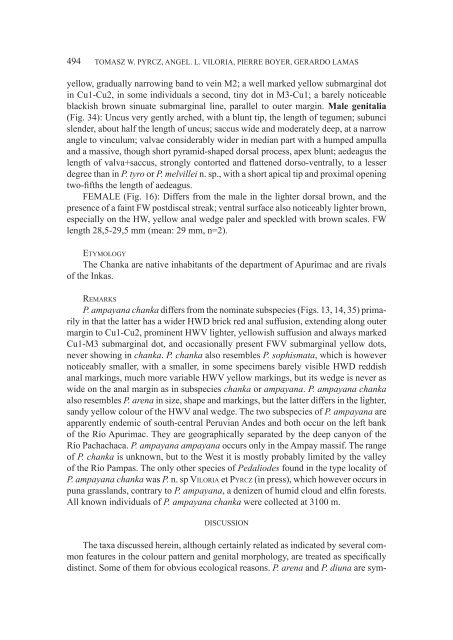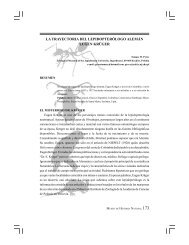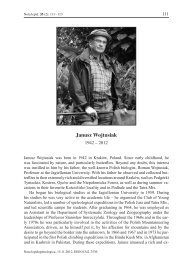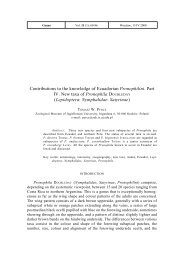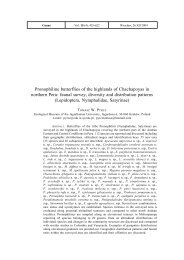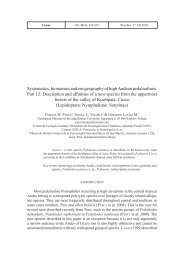Systematics, bionomics and zoogeography of high Andean ...
Systematics, bionomics and zoogeography of high Andean ...
Systematics, bionomics and zoogeography of high Andean ...
You also want an ePaper? Increase the reach of your titles
YUMPU automatically turns print PDFs into web optimized ePapers that Google loves.
494 Tomasz W. Pyrcz, Angel. L. Viloria, Pierre Boyer, Gerardo Lamas<br />
yellow, gradually narrowing b<strong>and</strong> to vein M2; a well marked yellow submarginal dot<br />
in Cu1-Cu2, in some individuals a second, tiny dot in M3-Cu1; a barely noticeable<br />
blackish brown sinuate submarginal line, parallel to outer margin. Male genitalia<br />
(Fig. 34): Uncus very gently arched, with a blunt tip, the length <strong>of</strong> tegumen; subunci<br />
slender, about half the length <strong>of</strong> uncus; saccus wide <strong>and</strong> moderately deep, at a narrow<br />
angle to vinculum; valvae considerably wider in median part with a humped ampulla<br />
<strong>and</strong> a massive, though short pyramid-shaped dorsal process, apex blunt; aedeagus the<br />
length <strong>of</strong> valva+saccus, strongly contorted <strong>and</strong> flattened dorso-ventrally, to a lesser<br />
degree than in P. tyro or P. melvillei n. sp., with a short apical tip <strong>and</strong> proximal opening<br />
two-fifths the length <strong>of</strong> aedeagus.<br />
FEMALE (Fig. 16): Differs from the male in the lighter dorsal brown, <strong>and</strong> the<br />
presence <strong>of</strong> a faint FW postdiscal streak; ventral surface also noticeably lighter brown,<br />
especially on the HW, yellow anal wedge paler <strong>and</strong> speckled with brown scales. FW<br />
length 28,5-29,5 mm (mean: 29 mm, n=2).<br />
Etymology<br />
The Chanka are native inhabitants <strong>of</strong> the department <strong>of</strong> Apurímac <strong>and</strong> are rivals<br />
<strong>of</strong> the Inkas.<br />
Remarks<br />
P. ampayana chanka differs from the nominate subspecies (Figs. 13, 14, 35) primarily<br />
in that the latter has a wider HWD brick red anal suffusion, extending along outer<br />
margin to Cu1-Cu2, prominent HWV lighter, yellowish suffusion <strong>and</strong> always marked<br />
Cu1-M3 submarginal dot, <strong>and</strong> occasionally present FWV submarginal yellow dots,<br />
never showing in chanka. P. chanka also resembles P. sophismata, which is however<br />
noticeably smaller, with a smaller, in some specimens barely visible HWD reddish<br />
anal markings, much more variable HWV yellow markings, but its wedge is never as<br />
wide on the anal margin as in subspecies chanka or ampayana. P. ampayana chanka<br />
also resembles P. arena in size, shape <strong>and</strong> markings, but the latter differs in the lighter,<br />
s<strong>and</strong>y yellow colour <strong>of</strong> the HWV anal wedge. The two subspecies <strong>of</strong> P. ampayana are<br />
apparently endemic <strong>of</strong> south-central Peruvian Andes <strong>and</strong> both occur on the left bank<br />
<strong>of</strong> the Río Apurimac. They are geographically separated by the deep canyon <strong>of</strong> the<br />
Río Pachachaca. P. ampayana ampayana occurs only in the Ampay massif. The range<br />
<strong>of</strong> P. chanka is unknown, but to the West it is mostly probably limited by the valley<br />
<strong>of</strong> the Río Pampas. The only other species <strong>of</strong> Pedaliodes found in the type locality <strong>of</strong><br />
P. ampayana chanka was P. n. sp Viloria et Pyrcz (in press), which however occurs in<br />
puna grassl<strong>and</strong>s, contrary to P. ampayana, a denizen <strong>of</strong> humid cloud <strong>and</strong> elfin forests.<br />
All known individuals <strong>of</strong> P. ampayana chanka were collected at 3100 m.<br />
DISCUSSION<br />
The taxa discussed herein, although certainly related as indicated by several common<br />
features in the colour pattern <strong>and</strong> genital morphology, are treated as specifically<br />
distinct. Some <strong>of</strong> them for obvious ecological reasons. P. arena <strong>and</strong> P. diuna are sym-


